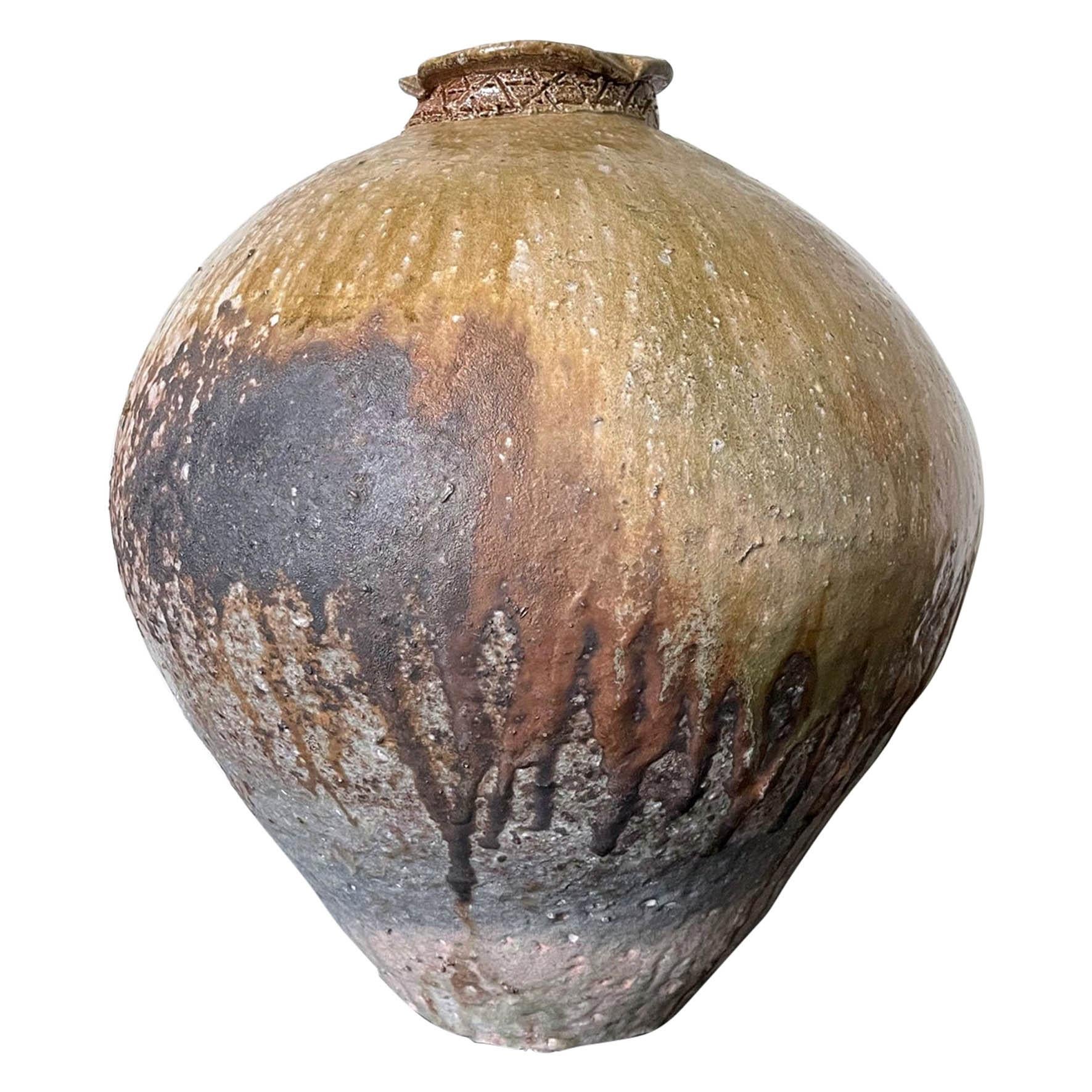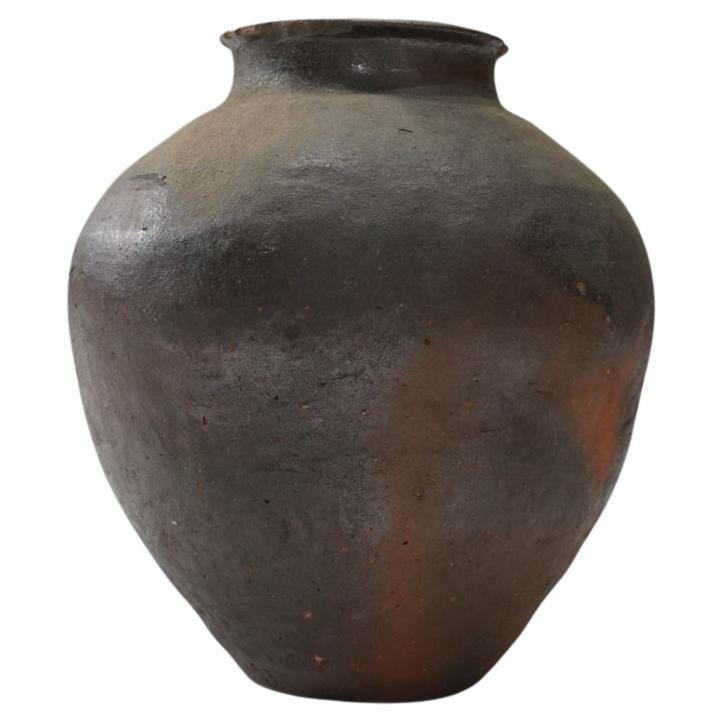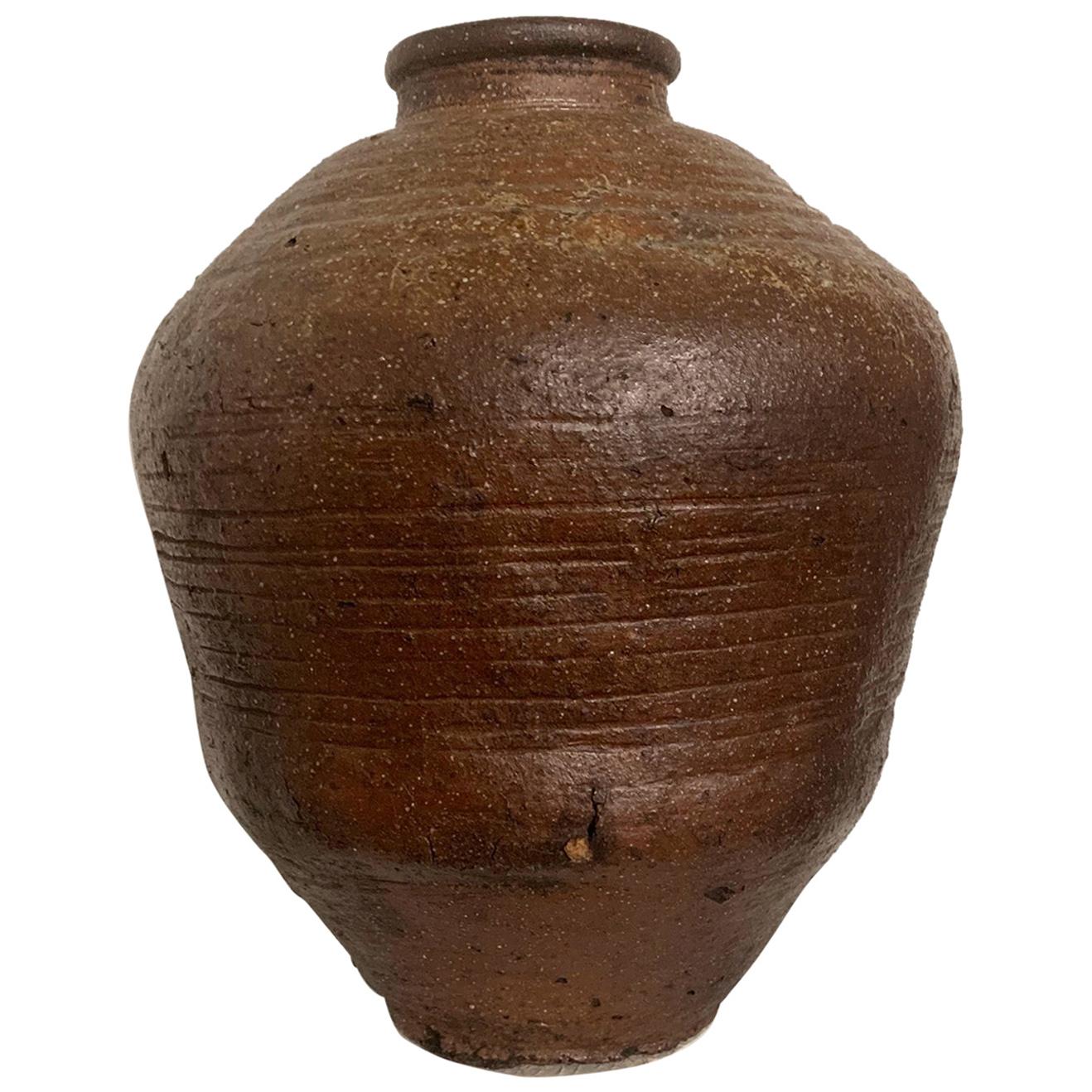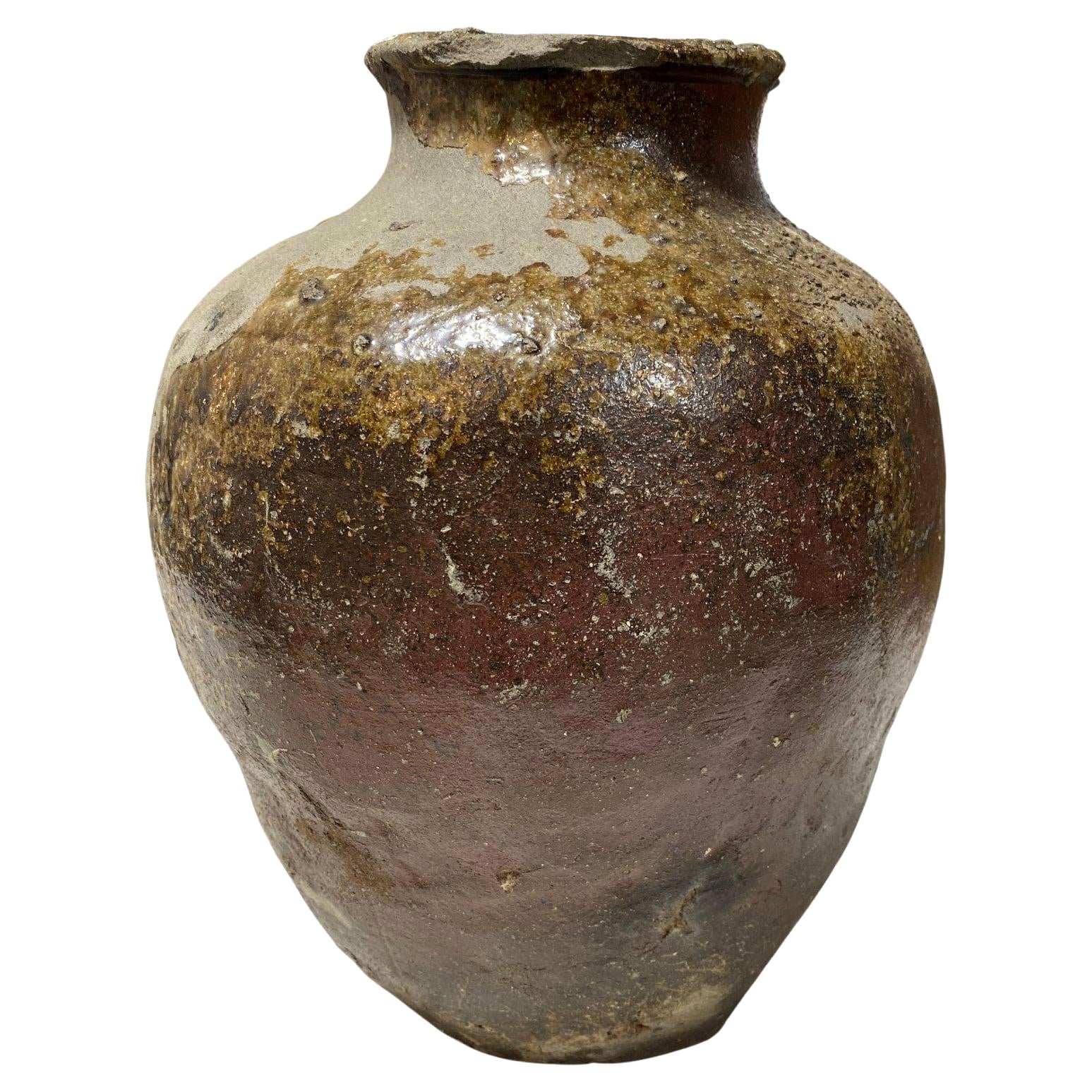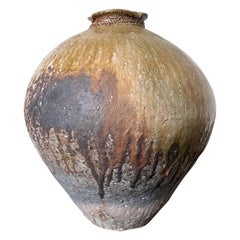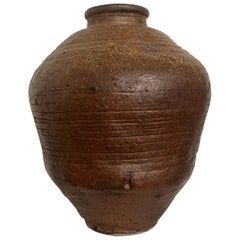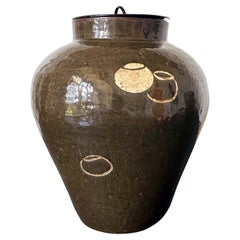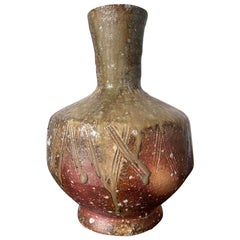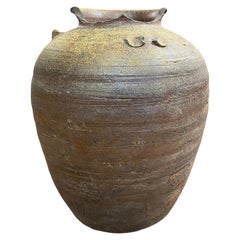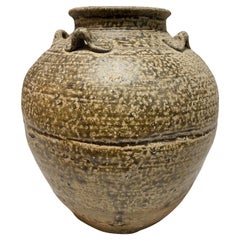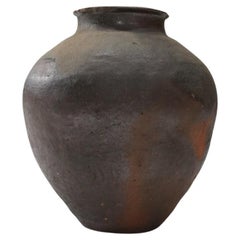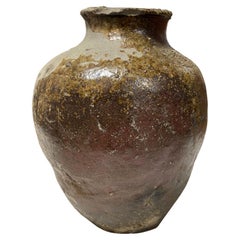Items Similar to Japanese Echizen Ceramic Tsubo Fujita Jurouemon VIII
Want more images or videos?
Request additional images or videos from the seller
1 of 20
Japanese Echizen Ceramic Tsubo Fujita Jurouemon VIII
$2,500
£1,898.31
€2,170.86
CA$3,492.86
A$3,884.83
CHF 2,028.54
MX$47,274.20
NOK 25,907.49
SEK 24,296.66
DKK 16,201.95
Shipping
Retrieving quote...The 1stDibs Promise:
Authenticity Guarantee,
Money-Back Guarantee,
24-Hour Cancellation
About the Item
A Japanese storage jar (tsubo) made in the ancient Echizen ware tradition by Fujita Jurouemon VIII. Echizen is one of the six ancient kilns in Japan, directly influenced by the Sue ware of the Heian period. Echizen ware is fired without applied glaze or decoration. Its surface is only marked with the natural ash splashes during the firing process. It is appreciated for its simple and robust form with an archaic appearance and randomly occurred surface texture. Fired at high temperature, Echizen yaki is a form of earthenware between pottery and porcelain, also called yakishime or semi-porcelain.
Fujita Jurouemon VIII (1922-2008) used the most traditional kiln and assumed the family head of the eight generation in 1967.
In 1975, he received Fukui Prefecture Traditional Kogei Excellent Successor Award.
The tsubo jar on offer is of a robust form, hand-built from coils and random ash glaze deposit on the surface. It reveals different view from various side. The base was not cut even, resulting in a slightly tilting form from certain angel as shown. It is marked on one side with a carved cross, the insignia of the artist. It comes with a wood storage box (tomobako) with inscription in Kanji (Echizen, Tsubo, and artist's name and seal). Also a paper label card and a brochure of the artist's info and technique.
- Dimensions:Height: 10.75 in (27.31 cm)Diameter: 11 in (27.94 cm)
- Style:Modern (Of the Period)
- Materials and Techniques:
- Place of Origin:
- Period:
- Date of Manufacture:20th Century
- Condition:Wear consistent with age and use. Base not cut even slightly tilting as made. Tomobako with some expected wear.
- Seller Location:Atlanta, GA
- Reference Number:1stDibs: LU945024688592
About the Seller
4.9
Platinum Seller
Premium sellers with a 4.7+ rating and 24-hour response times
Established in 2006
1stDibs seller since 2010
564 sales on 1stDibs
Typical response time: <1 hour
- ShippingRetrieving quote...Shipping from: Atlanta, GA
- Return Policy
Authenticity Guarantee
In the unlikely event there’s an issue with an item’s authenticity, contact us within 1 year for a full refund. DetailsMoney-Back Guarantee
If your item is not as described, is damaged in transit, or does not arrive, contact us within 7 days for a full refund. Details24-Hour Cancellation
You have a 24-hour grace period in which to reconsider your purchase, with no questions asked.Vetted Professional Sellers
Our world-class sellers must adhere to strict standards for service and quality, maintaining the integrity of our listings.Price-Match Guarantee
If you find that a seller listed the same item for a lower price elsewhere, we’ll match it.Trusted Global Delivery
Our best-in-class carrier network provides specialized shipping options worldwide, including custom delivery.More From This Seller
View AllLarge Ceremic Shigaraki Tsubo by Nagaoka Masami
Located in Atlanta, GA
An impressive Shigaraki Tsubo (jar normally for storage) in an archaic form with a bulbous and robust body that opens with a small lipped mouth. Heavil...
Category
21st Century and Contemporary Japanese Modern Ceramics
Materials
Ceramic
Large Japanese Antique Shigaraki Tsubo Jar
Located in Atlanta, GA
An antique Japanese stoneware storage jar, known as tsubo from Shigaraki kiln, circa 17th-18th century (early Edo possibly Momoyama period)....
Category
Antique 17th Century Japanese Japonisme Ceramics
Materials
Ceramic
Japanese Ceramic Seto Tea Leaf Tsubo Jar Edo Period
Located in Atlanta, GA
A Japanese glazed ceramic jar with a lacquered wood lid circa 19th century of late Edo to early Meiji Period. The stoneware tsubo was used as a storage vessel for produce such as tea...
Category
Antique 19th Century Japanese Edo Ceramics
Materials
Ceramic
Modern Japanese Ceramic Shigaraki Ikebana Vase Takahashi Shunsai
Located in Atlanta, GA
A tall ceramic vase made in the tradition of Shigaraki ware by Japanese potter Takahashi Shunsai (1927-2011), the fourth heir of the famed Rakusai lineage of potters. The vase is heavily potted in the reddish sandy Shigaraki clay. It has a Classic vase form made for Ikebana display. The surface is thickly draped with natural ash glaze that deposited onto the body during the firing process in the kiln. It also features decoration of carved lines. Nuggets of feldspar were incorporated in the clay and exposed onto the surface as crystal like jewels. Substantial and archaic looking, the vase also has a strong modern appeal due to its Mingei styling. It was signed on the base with a pressed seal Shunsai as shown. The vase comes with its original wood storage box (tomobako) with bears the title and signature in Kanji and a seal. It also retains a paperwork noting the artist's biography and practice philosophy in Japanese.
Born in Shigaraki, Shunsai was the second son of renowned potter Takahashi Rakusai...
Category
1990s Japanese Modern Ceramics
Materials
Ceramic
Japanese Ceramic Vase Mingei Style Hamada Shoji
By Hamada Shoji
Located in Atlanta, GA
A heavily potted stoneware vase in cylindrical form, decorated with abstract strokes in iron rust glaze (known as Persimmon Glaze in Japanese) on a black glazed background. The pattern suggests autumn grasses, and it was applied with free hands. The vase is attributed to Japanese potter Hamada Shoji...
Category
Late 20th Century Japanese Arts and Crafts Ceramics
Materials
Ceramic
Japanese Mishima Ceramic Vase Meiji Period
Located in Atlanta, GA
A Japanese long neck slender ceramic vase in the style of Mishima, circa 19th century, Meiji period. Mishima pottery was originally imported from three islands in Taiwan and then fro...
Category
Antique 19th Century Japanese Japonisme Ceramics
Materials
Ceramic
You May Also Like
Japanese Antique Momoyama Edo Bizen Ware Pottery Wabi-Sabi Art Tsubo Jar Vase
Located in Studio City, CA
An absolutely stunning Bizen ware stoneware vase/jar/vessel - produced sometime during the late Momoyama period (1568-1600) / Early Edo Period (1603-1867). Bizen yaki...
Category
Antique 16th Century Japanese Edo Ceramics
Materials
Stoneware
Japanese Antique Edo Wabi-Sabi Shigaraki Tamba Tanba Art Pottery Jar Tsubo Vase
Located in Studio City, CA
A beautiful Tamba (Tanba) ware (or Sigaraki ware) Japanese pottery vase/jar/pot - produced sometime during the Edo Period (1603-1867). Tamba-yaki ware is a type of Japanese pottery a...
Category
Antique 18th Century Japanese Edo Ceramics
Materials
Pottery, Stoneware
Japanese Antique Tsubo pot Flower Vase Wabi-Sabi
Located in Chiba, Chiba
This is an old Japanese vase.
There is a chip in the peristome.
There are several kiln marks on the body.
We will always suggest the best shipping method.
Please contact us first.
...
Category
Antique 19th Century Japanese Antiquities
Materials
Pottery
Japanese Antique Muromachi Edo Wabi-Sabi Tokoname Art Pottery Jar Tsubo Pot Vase
Located in Studio City, CA
An absolutely stunning Tokoname ware stoneware vase/jar/vessel - produced sometime during the late Muromachi period (1336-1573 to early Edo Period (1603-1867). Tokoname-yaki ware is ...
Category
Antique 16th Century Japanese Edo Ceramics
Materials
Pottery, Stoneware
Japanese Small Wabi Sabi Antique Pottery Vase/"Echizen Ware"/Edo/1600s
Located in Sammu-shi, Chiba
This is a Japanese Echizen ware pot.
It is "Echizenware".
Echizen is a historic kiln located in Ishikawa Prefecture, Japan.
(The Echizen kiln is marked with a red circle on the ma...
Category
Antique 17th Century Japanese Edo Vases
Materials
Pottery
Japanese antique pottery "Echizen ware" Large Jar/1500s/Rare large vase
Located in Sammu-shi, Chiba
It is "Echizen ware".
Echizen is a historic kiln located in Ishikawa Prefecture, Japan.
It is said to have originated around the 9th century.
There are 6 kilns with a long history in...
Category
Antique 16th Century Japanese Other Jars
Materials
Pottery


